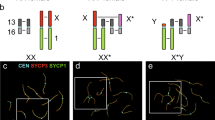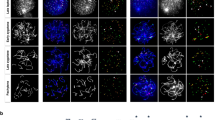Abstract
The pairing characteristics of the X axis in XO human and mouse oocytes were studied by the spreading technique throughout meiotic prophase. In three human XO foetuses, germ cell development was seen to be largely blocked at the preleptotene stage. In XO mice on the other hand, oocytes surviving through pachytene increasingly show the X axis making a non-homologous association with itself or with an autosome. Such associations take the form hairpins or rings when self pairing occurs or triradial structures when involvement is with an autosome. Pairing initiation in the autosomes involved is disturbed by the X axis suggesting that the heterologous pairing seen is taking place at the earliest stage of synaptonemal complex formation, namely zygotene. It is suggested, that in the XO mouse, and perhaps also in rare fertile XO humans, survival, of a population of oocytes into the adult is ensured by the ability of the X axis to pair non-homologously at meiotic prophase, thus satisfying pairing requirements.
Similar content being viewed by others
References
Ashley TA, Moses MJ, Solari AJ (1981) Fine structure and behaviour of a pericentric inversion in the sand rat, Psammomys obesus. J Cell Sci 50:105–119
Beaumont HM, Mandl AM (1962) A quantative and cytological study of oogonia and oocytes in the foetal and neonatal rat. Proc Soc Lond B 155:557–579
Burgoyne PS, Baker TG (1981a) The XO ovary development and function. In: Byskov AG, Peters H (eds) Development and function of reproductive organs. Excerpta Medica, Amsterdam, pp 122–128
Burgoyne PS, Baker TG (1981b) Oocyte depletion in XO mice and their XX sibs from 12 to 200 days post partum. J Reprod Fertil 61:207–212
Burgoyne PS, Baker TG (1984) Meiotic pairing and gametogenic failure. In: Evans CW, Dickinson HG (eds) Controlling events in meiosis. Company of Biologists, Cambridge, pp 349–362
Burgoyne PS, Baker TG (1985) Perinatal oocyte loss in XO mice and its implications for the aetiology of gonadal dysgenesis in XO women. J Reprod Fertil 75:633–645
Carr DH, Haggar RA, Hart AG (1968) Germ cells in the ovaries of XO female infants. Am J Clin Pathol 49:521–526
Carr DH (1972) Cytogenetic aspects of induced and spontaneous arbortions. Clin Obstet Gynaecol 15:203–219
Cattanach BM (1962) XO mice. Genet Res 3:487–490
Chandley AC (1984) Infertility and chromosome abnormality. In: Clarke JR (ed) Oxford reviews of reproductive biology. Oxford University Press, Oxford, pp 1–46
Cooper KW (1964) Meiotic conjunctive elements not involving chiasma. Proc Natl Acad Sci USA 52:1248–1255
Dewhurst J (1978) Fertility in 47,XXX and 45,X patients. J Med Genet 15:132–135
Eicher EM, Washburn LL (1978) Assignment of genes to regions of mouse chromosomes. Proc Natl Acad Sci USA 75:946–950
Evans EP, Phillips RJS (1975) Inversion heterozygosity and the origin of XO daughters of Bpa/+ female mice. Nature 256:40–41
Gillies CB (1974) The nature and extent of synaptonemal complex formation in haploid barley. Chromosoma 48:441–453
Gillies CB (1983) Ultrastructural studies of the association of homologous and non-homologous parts of chromosomes in the mid-prophase of meiosis in Zea mays. Maydica XXVIII:265–287
Hasenkamf CA (1984) Synaptonemal complex formation in pollen mother cells of Tradescantia. Chromosoma 90:275–284
Hobolth P (1981) Chromosome pairing in allohexaploid wheat var Chinese Spring. Transformation of multivalents into bivalents, a mechanism for exclusive bivalent formation. Carlsberg Res Commun 46:129–173
Holm PB (1977) Three-dimensional reconstruction of chromosome pairing during the zygotene stage of meiosis in Lilium longiflorum (Thunb). Carlsberg Res Commun 42:103–151
John B, Lewis KR (1965) The meiotic system. Protoplasmalogia 6:1–335
King CR, Magenis E, Bennett S (1978) Pregnancy and the Turner syndrome. Obstet Gynecol 52:617–624
Eevan A (1942) Studies on the meiotic mechanism of haploid rye. Hereditas 28:177–211
Lyon MF, Hawker SG (1973) Reproductive life span in irradiated and unirradiated XO mice. Genet Res 21:185–194
McClintock B (1933) The association of non-homologous parts of chromosomes in the mid-prophase of meiosis in Zea mays. Z Zellforsch 19:191–237
Menzel MY, Price JM (1966) Fine structure of synapsed chromosome in f1 Lycopersicon esculentum-Solanum lycopersicoides and its parents. Am J Bot 53:1079–1086
Miklos GLG (1974) Sex chromosome pairing and male fertility. Cytogenet Cell Genet 13:558–577
Moens PB (1968) The structure and function of the synaptonemal complex in Lilium longiflorum sporocytes. Chromosoma 23:418–451
Moses MJ (1977) Microspreading and the synaptonemal complex in cytogenetic studies. In: Chapelle A de la, Sorsa M (eds) Chromosomes today. Elsevier/North Holland, Biomedical Press, Amsterdam, pp 71–82
Phillips RJS, Hawker SC, Moseley HJ (1973) Bare patches, a new sex-linked gene in the mouse, associated with a high proportion of XO females. I. A preliminary report of breeding experiments. Genet Res 22:91–99
Reiger R (1957) Inhomologenpaarung und Meioseablauf bei haploiden Formen von Antirrhinum majus L. Chromosoma 9:1–38
Reyes FI, Koh KS, Faiman C (1976) Fertility in women with gonadal dysgenesis. Am J Obstet Gynecol 6:669–670
Sadasivaiah RS, Kasha KJ (1971) Meiosis in haploid barley — an interpretation of non-homologous chromosome associations. Chromosoma 35:247–263
Singh RP, Carr DH (1966) The anatomy and histology of XO human embryos and fetuses. Anat Rec 155:369–384
Speed RM (1982) Meiosis in the foetal mouse ovary. I. An analysis at the light microscope level using surface-spreading. Chromosoma 85:427–437
Speed RM (1985) The prophase stages in human foetal oocytes studied by light and electron microscope. Hum Genet 69:69–75
Speed RM (1986) Prophase pairing in a mosaic 18p−; iso 18q human female foetus studied by surface speading. Hum Genet 72:256–259
Speed RM, Chandley AC (1983) Meiosis in the foetal mouse ovary. II. Oocyte development and age-related aneuploidy. Does a production line exist? Chromosoma 88:184–189
Welshons WJ, Russell LB (1959) The Y-chromosome as the bearer of male determining factors in the mouse. Proc Natl Acad Sci USA 45:560–566
Wettstein D von, Rasmussen SW, Holm PB (1984) The synaptonemal complex in genetic segregation. Annu Rev Genet 18:331–413
Author information
Authors and Affiliations
Rights and permissions
About this article
Cite this article
Speed, R.M. Oocyte development in XO foetuses of man and mouse: the possible role of heterologous X-chromosome pairing in germ cell survival. Chromosoma 94, 115–124 (1986). https://doi.org/10.1007/BF00286989
Received:
Revised:
Issue Date:
DOI: https://doi.org/10.1007/BF00286989




